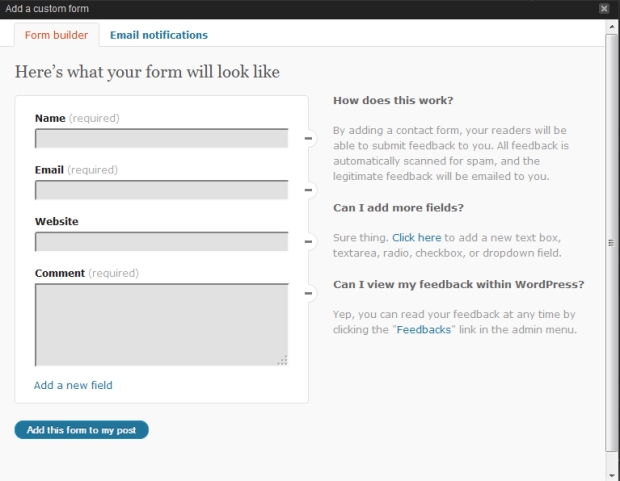Last month, we highlighted bloggers writing about mental health issues — and it struck a chord with many of you.
Lots of you commented that you also write about struggles with mental health, and were hoping your blogs would be a medium to help you connect with others and a safe space for talking about sensitive issues. There are two features baked into WordPress.com to support both goals.
Contact forms
Unfortunately, there’s still a good deal of stigma around mental illness, making many of us uncomfortable being public about our struggles. Leaving a public comment on someone’s blog isn’t always easy on fun posts, let alone on something as fraught with judgement as mental health.
Putting a contact form on your blog gives readers a way to connect with you privately. They can share their own stories and offer support without having to reveal more than they’re comfortable with to the internet at large.
To insert a form into a post or page, click the “Add Contact Form” button at the top of the Visual or Text Editor to pull up the form builder, which looks like this:

You can edit the fields, delete them, or add more — it all depends on what you’d like your form to say and do. As you create the form, you’ll see a preview of it right in the form builder. When you’re satisfied, click “Add this form to my post.”
(Note: when you click “Add,” the form tool will convert your form to code and you won’t see the actual form in your editing window. Don’t worry, your form is there — to see it, save your post and preview it.)
In its simplest version, a contact form could simply provide space to input a name and note. You can even decide not to make fields like “name” required, to give people the option to be totally anonymous.

In the “Email Notifications” tab of the tool, you can set the email address you’d like to use to receive responses (the default is the address you use with WordPress.com). You can also review responses in your dashboard.
Using a contact form protects your privacy as well as your reader’s: if you blog anonymously or pseudonymously and would prefer not to list an email address on your blog, it allows readers to get in touch without revealing your identity.
Privacy settings
Sometimes, you need to write or have updates to share, but you’d only like family, friends, and/or regular readers to be able to view them. For these truly sensitive posts, take advantage of privacy settings.
 You can set entire blogs to be private and password-protected, but you can also control access on a per-post basis by password-protecting individual posts. Head to the “Visibility” settings in the publish box (at left), select “Password protected,” pick a password, and give it to those you’d like to be able to see the post.
You can set entire blogs to be private and password-protected, but you can also control access on a per-post basis by password-protecting individual posts. Head to the “Visibility” settings in the publish box (at left), select “Password protected,” pick a password, and give it to those you’d like to be able to see the post.
If you need to go further, the “Private” option makes the post invisible to all but WordPress.com users who are Administrators or Editors of your blog (here’s a rundown on user roles if you need a refresher).
To cultivate a community or collaborative blog, you may choose to make the entire site private and password-protected. To set a blog to be private, head to Settings ? Reading in your dashboard, scroll down to “Site visibility,” and select “Private.” Visitors will get a pop-up notice prompting them to request access, and you’ll have a safe community where you all know one another and can share stories out of the public blogging eye.
For really active communities, try a theme like P2, which allows a blog’s users to post and comment from the home page, and has real-time commenting. It’s how we collaborate internally at WordPress.com and is great for conversation-oriented communication.
By starting a blog to write about your experiences, you’ve already taken a big step toward becoming part of a community that can be a worldwide support network. We’re happy WordPress.com offers additional tools to help you carve out and control a supportive, safe space.
Filed under: Better Blogging, Community
